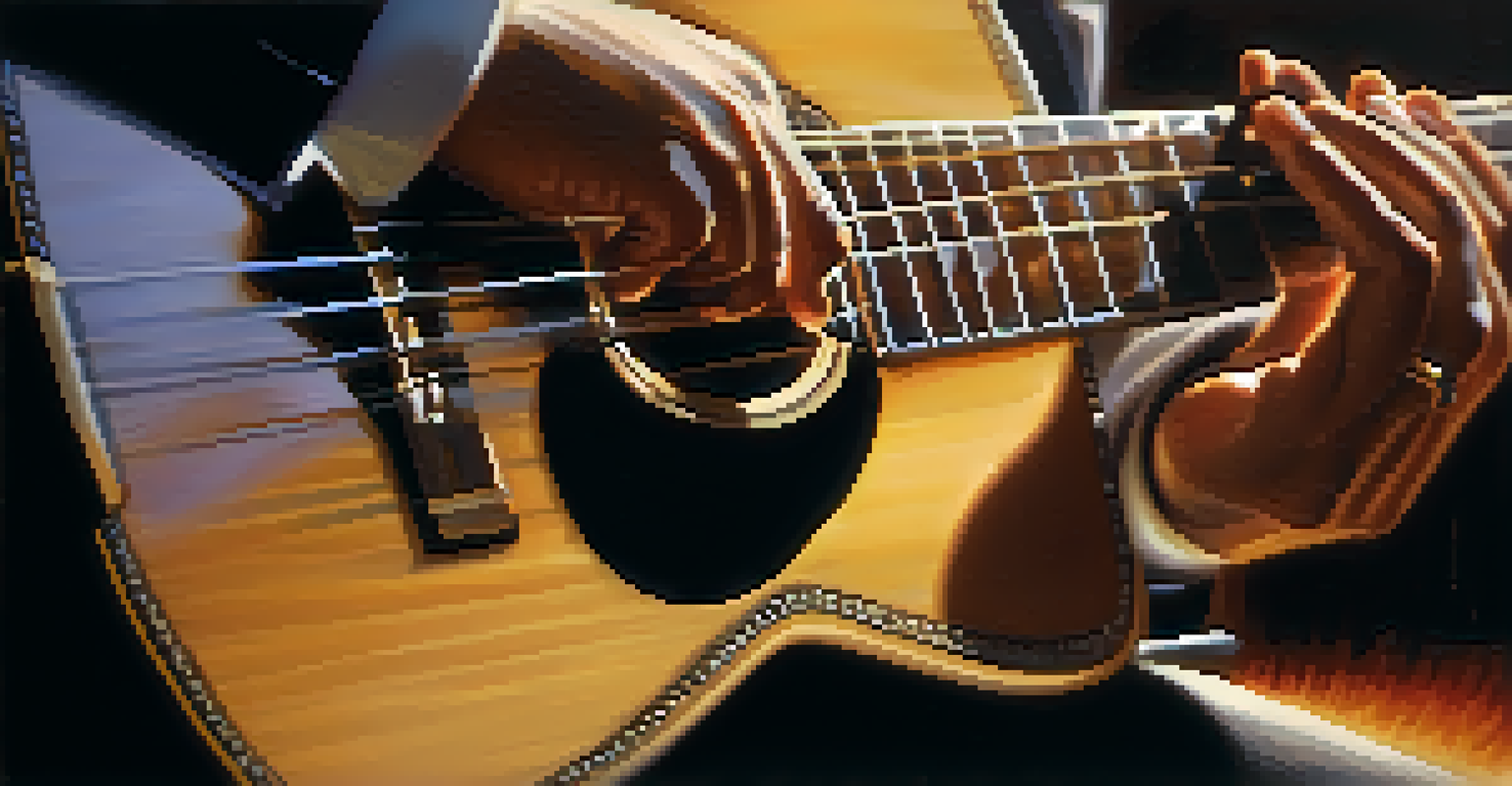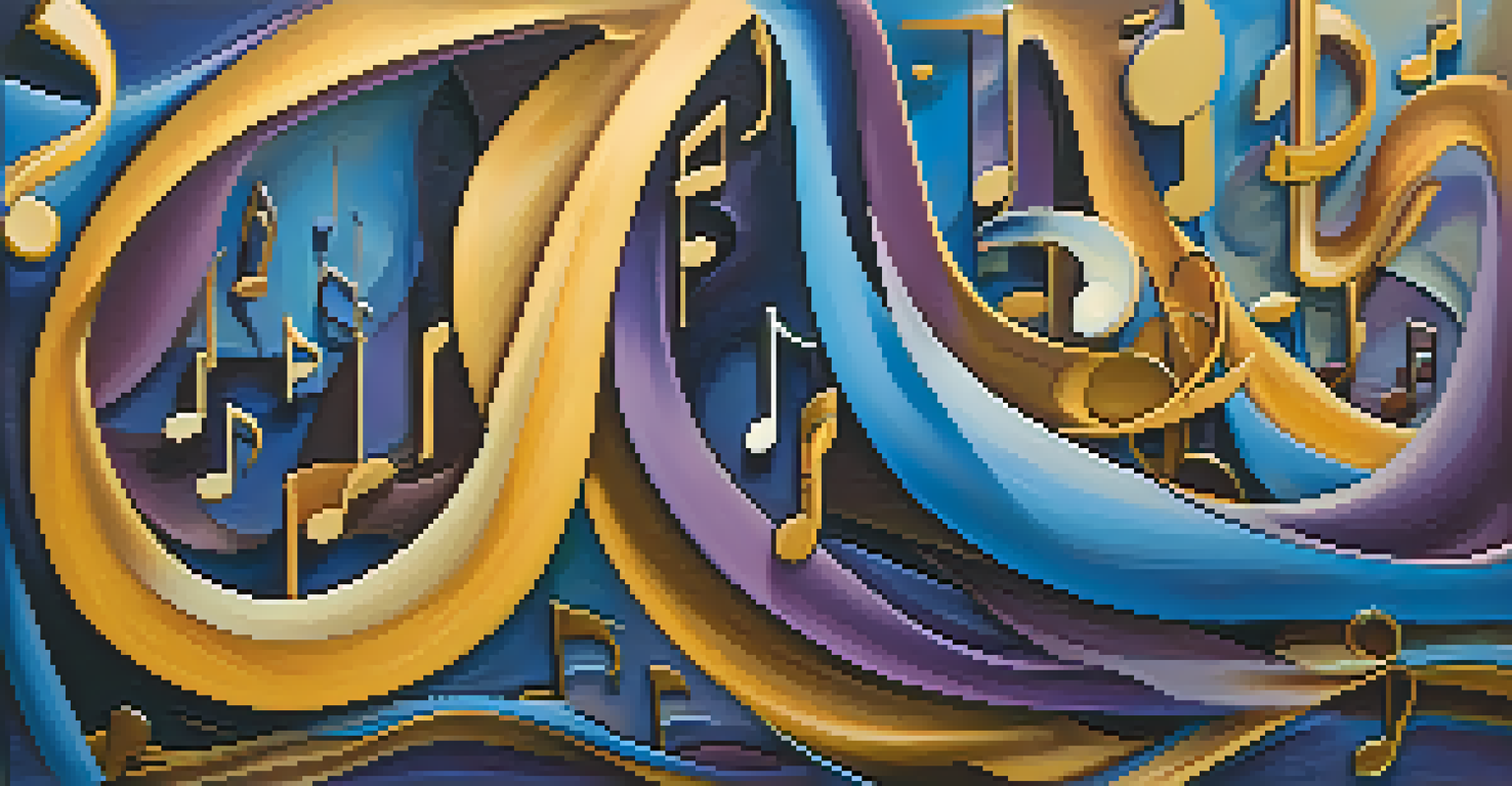Using Bridge Sections Effectively in Guitar Songs

Understanding the Role of Bridge Sections in Music
Bridge sections serve as a contrast to the verses and choruses of a song, providing a refreshing change in melody and rhythm. They often introduce new ideas or emotions, helping to keep the listener engaged. Think of a bridge as a scenic detour on a well-traveled road; it offers a new perspective before you return to familiar territory.
Music can change the world because it can change people.
In many popular songs, bridges create a pivotal moment that can elevate the emotional intensity. For example, in 'Wonderwall' by Oasis, the bridge shifts the song’s energy, adding depth to the overall narrative. This strategic use of contrast not only highlights the core themes but also enhances the listener's experience.
Ultimately, understanding the purpose of a bridge section is crucial for songwriting. It’s not merely a filler; it’s a vital component that can transform a good song into a memorable one. By acknowledging its role, you’ll be better equipped to harness its power in your compositions.
Crafting Memorable Melodies for Your Bridge
A great melody can make your bridge stand out, capturing the listener’s attention in a new way. Focus on creating a simple yet captivating melody that contrasts with the rest of the song. This could mean shifting to a different scale or using unexpected chord progressions that surprise your audience.

For instance, consider using a descending melody in your bridge if the verses feature an ascending pattern. This contrast not only adds interest but also creates a sense of movement and evolution in the song. Think of it like a roller coaster ride, where the highs and lows keep you thrilled throughout.
Bridges Add Emotional Depth
Bridge sections provide contrast and elevate emotional intensity in songs, making them memorable.
When writing your bridge melody, remember to keep it singable. A memorable melody is one that listeners can hum along to, even after the song is over. By balancing complexity with accessibility, your bridge can leave a lasting impression.
Building Tension and Release in Bridge Sections
Tension and release are foundational elements in music, and bridges are the perfect place to explore them. By building tension in the bridge, you can create a sense of anticipation that makes the return to the chorus even more impactful. This can be achieved through various techniques, such as increasing dynamics or introducing dissonant chords.
The bridge is where you can create some of the most beautiful and poignant moments in a song.
A classic example of this is found in Queen's 'Bohemian Rhapsody,' where the bridge heightens tension before the explosive return to the chorus. This contrast not only enhances the emotional journey but also keeps the listener on the edge of their seat. Just like the suspense in a good book, the tension in your bridge can compel your audience to keep listening.
To effectively build tension, experiment with different rhythmic patterns or variations in your chord progressions. The goal is to create a moment that feels urgent and necessary, leading seamlessly back into the familiar refrain. This strategic setup can elevate your songwriting to new heights.
Using Lyrics to Enhance Your Bridge Section
Lyrics play a crucial role in conveying the emotional weight of your bridge. This section often serves as a reflection or a turning point in the narrative of your song. By using evocative language and vivid imagery, you can deepen the impact of your bridge, making it a highlight of the composition.
For example, if your verses are focused on a relationship, the bridge might explore a moment of doubt or realization. This shift in perspective can add layers to the story, inviting the listener to connect on a more personal level. Think of it as peeling back the layers of an onion; each layer reveals something new and poignant.
Melody and Lyrics Matter
Crafting captivating melodies and impactful lyrics in the bridge enhances the listener's experience.
When crafting your bridge lyrics, aim for brevity and clarity. A few powerful lines can often resonate more than lengthy verses. Remember, the bridge is a moment of reflection; make it count by ensuring your words resonate with the overall theme of your song.
Experimenting with Different Musical Styles in Bridges
One of the joys of songwriting is the freedom to experiment, especially in your bridge sections. This is your opportunity to step outside the established style of your song and explore new musical ideas. Incorporating elements from different genres or styles can create a unique contrast that captivates your audience.
For instance, if you’re writing a pop song, consider infusing some jazz chords or a bluesy riff in the bridge. This unexpected twist can surprise listeners and keep them engaged. It’s like adding a splash of color to a monochromatic painting; it draws the eye and adds depth.
Embrace the creative process during this phase. Allow yourself to stray from the norm and take risks with your musical choices. You may discover innovative sounds and ideas that elevate your song far beyond your original vision.
Transitioning Smoothly from the Bridge to the Chorus
A smooth transition from the bridge back to the chorus is vital to maintain the flow of your song. After building tension or introducing new ideas, it’s essential that the return feels natural and fluid. This can be achieved through various techniques, such as using a common chord or a dynamic build-up that leads seamlessly into the chorus.
For example, in many rock songs, the bridge often culminates in a powerful drum fill or a crescendo that directly leads into the chorus. This technique not only emphasizes the return but also amplifies the emotional impact of the song. Think of it like a well-timed punchline; the delivery can make all the difference.
Smooth Transitions Enhance Flow
A seamless transition from the bridge to the chorus is crucial for maintaining the song's overall cohesiveness.
To create an effective transition, consider the energy levels and dynamics of both sections. Make sure the bridge prepares the listener for what comes next, enhancing the overall cohesiveness of your song. A well-executed transition can elevate your composition to a professional level.
Analyzing Famous Bridges for Inspiration
One of the best ways to understand how to write effective bridges is to analyze songs that excel in this area. Listen to hits across genres and pay attention to how their bridges function within the overall structure. This can provide valuable insights into melody, lyrics, and transitions that resonate with listeners.
Take 'Billie Jean' by Michael Jackson, for example. The bridge introduces a compelling narrative shift that captivates the audience's attention before returning to the iconic chorus. By dissecting these moments, you can identify techniques that work well and apply them to your own songwriting.

Don’t hesitate to take notes while listening to your favorite songs. Jot down what you like about the bridges and think about how you can incorporate similar ideas into your work. Inspiration often strikes when you least expect it, so keep your ears open!